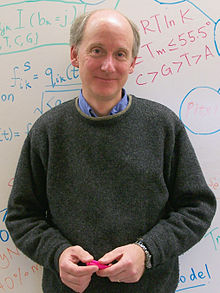James Thomson (cell biologist)
| James Alexander Thomson | |
|---|---|

Jamie Thomson (Photo: Jane Gitschier)
|
|
| Born | December 20, 1958 Oak Park, Illinois, U.S. |
| Citizenship | United States |
| Fields | Developmental biology |
| Institutions |
Morgridge Institute for Research University of Wisconsin, Madison University of California, Santa Barbara |
| Alma mater |
University of Illinois at Urbana-Champaign (1981) |
| Known for | Stem cell research |
University of Illinois at Urbana-Champaign (1981)
James Alexander Thomson (born December 20, 1958) is an American developmental biologist best known for deriving the first human embryonic stem cell (SC) line in 1998 and for deriving human induced pluripotent stem cells (iPS) in 2007.
Human embryonic stem cells can divide without limit, and yet maintain the potential to make all the cells of the body. This remarkable potential makes them useful for basic research on the function of the human body, for drug discovery and testing, and as a source of cells and tissues for transplantation medicine. In 1998, Thomson’s Lab was the first to report the successful isolation of human embryonic stem cells. On November 6, 1998, Science published this research in an article titled "Embryonic Stem Cell Lines Derived from Human Blastocysts", results which Science later featured in its “Scientific Breakthrough of the Year” article, 1999.
In spite of their great medical potential, however, human embryonic stem cells generated enormous controversy because their derivation involved the destruction of a human embryo. In 2007, Thomson’s group (contemporaneously with Dr. Shinya Yamanaka) reported a method for converting human skin cells into cells that very closely resemble human embryonic stem cells. Published in Science in late 2007 in an article titled "Induced Pluripotent Stem Cell Lines Derived from Human Somatic Cells", the results garnered international attention for potentially ending the ethical controversy surrounding human embryonic stem cell research. Science later featured induced pluripotent stem cells in its “Scientific Breakthrough of the Year” article, 2008.
Thomson graduated with a B.S. in biophysics from the University of Illinois in 1981. He entered the Veterinary Medical Scientist Training Program at the University of Pennsylvania, receiving his doctorate in veterinary medicine in 1985, and his doctorate in molecular biology in 1988. His doctoral thesis involved understanding genetic imprinting in early mammalian development under the mentorship of Davor Solter at the Wistar Institute. Thomson also spent two years (1989–91) as a postdoctoral research fellow in the Primate In Vitro Fertilization and Experimental Embryology Laboratory at the Oregon National Primate Research Center, and completed a residency in veterinary pathology at the University of Wisconsin–Madison (1991–1994).
...
Wikipedia
